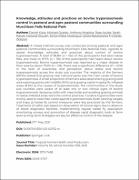| dc.contributor.author | Kizza, Daniel | |
| dc.contributor.author | Ocaido, Michael | |
| dc.contributor.author | Mugisha, Anthony | |
| dc.contributor.author | Azuba, Rose | |
| dc.contributor.author | Nalule, Sarah | |
| dc.contributor.author | Onyuth, Howard | |
| dc.contributor.author | Musinguzi, Simon Peter | |
| dc.contributor.author | Nalubwama, Sylvia | |
| dc.contributor.author | Waiswa, Charles | |
| dc.date.accessioned | 2024-03-20T12:35:20Z | |
| dc.date.available | 2024-03-20T12:35:20Z | |
| dc.date.issued | 2021-05-07 | |
| dc.identifier.issn | 1573-7438 ELectronic | |
| dc.identifier.issn | 0049-4747 Print | |
| dc.identifier.other | DOI: 10.1007/s11250-021-02752-w | |
| dc.identifier.uri | http://hdl.handle.net/20.500.12280/3072 | |
| dc.description.abstract | A mixed method survey was conducted among pastoral and agro pastoral communities surrounding Murchison Falls National Park, Uganda to assess knowledge, attitudes and practices about control of bovine trypanosomosis. A total of 96.8% (n = 152) of the participants had seen tsetse flies, and close to 91.7% (n = 116) of the participants had heard about bovine trypanosomosis. Bovine trypanosomosis was reported as a major disease in their area by about 73.9% (n = 116). There was a significant difference (P < 0.05) in the level of awareness and perception about tsetse and bovine trypanosomosis across the study sub counties. The majority of the farmers (60.5%) stated that grazing near national parks was the main cause of bovine trypanosomosis. A small proportion of farmers associated sharing grazing land and watering points with wildlife (19.1%) and grazing cattle in tsetse fly-infested areas (8.3%) as the causes of trypanosomosis. The communities in the study sub counties were aware of at least one or two clinical signs of bovine trypanosomosis. Spraying cattle with insecticide and avoiding grazing animals in tsetse-infested areas were the control practices. Curative trypanocides were mainly used to treat their cattle against trypanosomosis. Bush clearing, targets and traps as tsetse fly control measures were less practiced by the farmers. Treatment of cattle was based on observation of clinical signs due to absence of blood diagnostic facilities. Implementing regular tsetse fly population monitoring surveys and promotion of disease rapid diagnostic tools at farm level as long-term strategies are key for effective control of the disease. | en_US |
| dc.language.iso | en | en_US |
| dc.publisher | Springer Link | en_US |
| dc.relation.ispartofseries | Tropical Animal Health and Production;Volume 53, Article Number 309, 2021 | |
| dc.subject | Pastoral community | en_US |
| dc.subject | Agro pastoral community | en_US |
| dc.subject | Murchison Falls National Park | en_US |
| dc.subject | Bovine trypanosomosis | en_US |
| dc.title | Knowledge, attitudes and practices on bovine trypanosomosis control in pastoral and agro pastoral communities surrounding Murchison Falls National Park | en_US |
| dc.type | Article | en_US |


